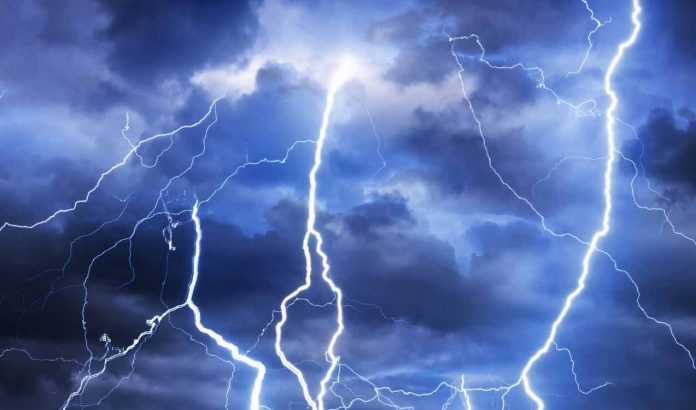Scientists have used high-speed video to capture a fleeting moment of connection that sets the path of a lightning flash.
A new study reports two consecutive images, each representing 1/380-thousandth of a second, illuminating how downward-questing lightning fingers from a lightning cloud, called lightning leaders, and upward reaching leaders from the ground, make the final jump to meet in a lightning flash.
Many lightning leaders coming from thunderclouds seek the connection to the ground, but generally only one lightning channel will form, and its path is unpredictable. The new study reports the best resolution detection of the connection process to date.
“It is a very important issue because, in lightning development, there are a lot of branches. The target of the lightning strike is not determined at the beginning when it initiates from the cloud. The attachment process is the process that eventually determines the object that’s struck by the lightning flash,” said Rubin Jiang, an atmospheric physicist at the Chinese Academy of Sciences Laboratory for Middle Atmosphere and Global Environment Observation and a co-lead author of the new study published today in AGU’s Geophysical Research Letters, AGU’s journal for high-impact, short-format reports with immediate implications spanning all Earth and space sciences.
“Our study makes more specific the breakthrough phase. That means when two lightning leaders get close enough to each other and they have not completely connected. In lightning research history it is the so-called ‘final jump,’” Jiang said.
This moment of attachment happens so quickly scientists have not had a clear picture of whether several close lightning leader streamers coalesce and shrink into a single channel, like laced fingers clasping, or single positive and negative streamers meet, like Michelangelo’s famous fresco of the creation of Adam, and become the sole channel that heats up to the lightning flash.
The new study suggests the single connection of the second scenario is more likely.
“Until now, by the natural lightning observation only one frame is observed of this phase, because it is happening in microseconds,” said Abhay Srivastava, a research scientist at the North Eastern Space Applications Centre in Meghalaya, India, and co-lead author of the new study. “We observed more than one frame, so we can separate out what is happening over that final jump.
Connection in a flash
The visible flash of lightning is the culmination of a process that begins when negative charge builds in a thundercloud. The concentration of negative charge overhead induces a complementary positive charge on the ground. Cloud-to-ground lightning is the flow of electricity between these fields. It requires an intense build-up of charge because air is not a good conductor.
The build-up in the cloud charges nearby air molecules, creating a more conductive medium. The charged cloud sends out faint, low-current “stepped leaders” that can jump tens of meters in microseconds, branching frequently. Bursts of streamers from the leader tips initiate each step, and this streamer zone is believed to make first contact with counterparts from the ground.
As the negatively charged leaders near the ground, they call leaders upward from positively charged objects on the ground. Scientists call the moment of contact the breakthrough phase. At that moment, the path of the lightning flash is set. A low-current common streamer zone forms and quickly heats to a plasma channel that can carry a high current of charged particles and the bright return stroke from the ground lights the sky in a lightning flash. An open question is whether this contact is made by one streamer, or many converging on a single path.
The new study caught this breakthrough phase of a lightning strike on a 325-meter (1000-foot) meteorology tower in Beijing, China, on high-speed video. Two frames showed downward and upward leaders formed a common streamer zone when they came within 23 meters (75 feet) of each other. A single luminous thread in this zone suggested first contact between streamers of upward and downward leaders, according to the authors.
This thin connection grew into the lightning discharge channel, lending support to the idea that the early contact between streamers of upward and downward lightning leaders sets the route of the lightning flash, but the authors would need more observations to confirm it.





























